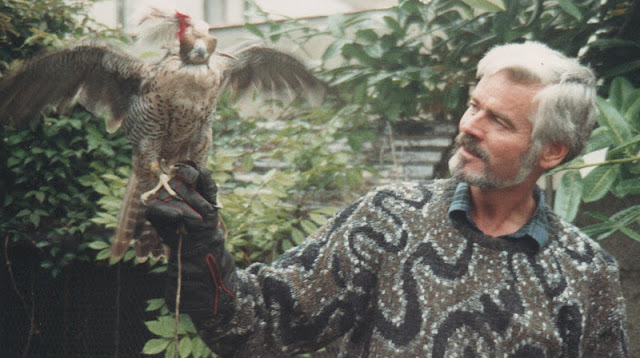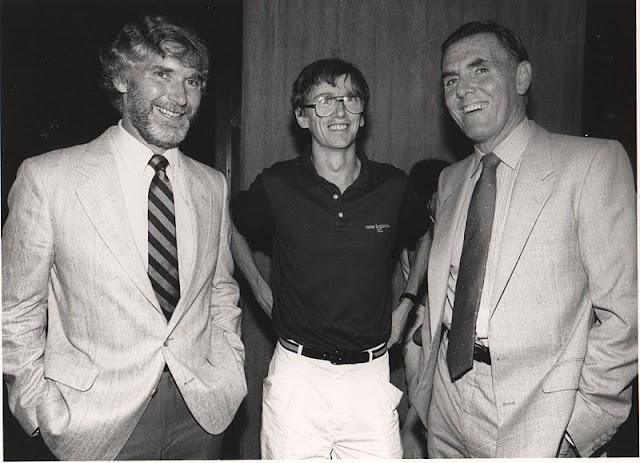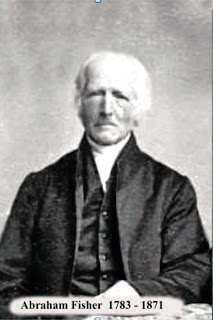Please note, photos are from private collection and (c)
Eddie
 |
| Tom Cheasty |
Sometime during the winter of 1961 John Harty encouraged me to
travel to Dunhill in his car to participate in the county juvenile (under-16)
cross-country championship. I remember that we collected another young lad in
Ballinroad (possibly Tony McCarthy?), who as far as I can recall won the
juvenile title that day. For my part, I had little or no experience of
competitive running and I don't think that I even finished the race. What does stick in my memory is that the
senior title was won by that great Dunhill all-rounder, Mick White, while the
junior race victor was Tom Cheasty, who just shaded it over John Harty.
Tom, in his hey-day, was notably
broad-shouldered, with a build that certainly did not fit the profile for
distance running - but he was, in all probability, using cross-country as part
of his physical conditioning for hurling.
 |
| Paud at the finish of the Boston City marathon in 1986 with the lads from South Hill limerick |
In 1962-63 I attended Pallaskenry Agricultural College in Limerick,
where one had a chance to sample all kinds of athletic endeavour. While I could
hold my own at football (having won a county junior championship with An Rinn
that year), insofar as running was concerned it became clear to me that I did
not have the natural speed for the shorter races and was probably the wrong
build for the serious distance stuff. However, within these limitations I was
to derive huge enjoyment from running for fun, mainly on the road, until I was
well into my fifties.
 |
| Pallaskenry Agricultural College |
 |
| Rideau Canal |
While I always had an interest in running throughout the sixties
football was my main sport at that time. It was only when I lived in Ottawa,
Canada between 1976 and 1980 that I really began to devote the time to it.
Ottawa has the wonderful Rideau Canal flowing through its centre and, while it
turns into a large skating rink in winter, it had a tarred pathway for
pedestrians and cyclists along its banks, which went on for many miles. I
worked downtown and we lived in a suburb five or six miles away and it was
ideal to be able to run home after work (much of the jog taking me along the
scenic banks of the Rideau Canal). In addition, Ottawa hosted an international
indoor track meet and it was fantastic to see the great Eamonn Coghlan compete
in a 5000 metres race on one occasion.
The
city also hosted an annual marathon race, and while I did not participate in
this or indeed any other organised race at the time, it was clear that I had a
growing interest in doing so.
The other interesting development at that
time was the emergence of the highly designed and engineered running shoe.
Adidas, I believe, led the way and the era saw a growing linkage between
fashion and sportswear, which continues to evolve. It was a long way from the
cheap, flat-soled, canvas running footwear that we wore in our youth!
I was friendly with a fellow from Co. Clare
called Seán Egan, who was an
 |
| The late, Seán Egan |
academic at the
University of Ottawa. We played together on
the Ottawa Gaels football team (in 1977, I added a Canadian junior title to my
Waterford one!).
Seán
was a super-fit individual who could decide to run a marathon on a whim. In
April 2005 the same man tragically lost his life on the slopes of Mount Everest
while attempting, at 63 years, to be the oldest Canadian to summit that mighty
mountain.
At home in An Rinn great things were happening on the athletic
front. The marvelous exploits of St. Nicholas A.C., mentored by Fr.
Michael Enright with the assistance of others such as John Harty and Paddy Joe
Curran, had become a national story. I was away from it all but my brother,
Kevin, and sister, Līse, were very much involved with the club. However, it was
the emergence of John Treacy as an iconic figure for club, country and country
that made that era a truly golden one.
 |
| Paud Curran admires Seán Treacy's Olympic medal 1984 Boston, right is Brendan Rogers |
When I returned from Ottawa and was living
in Dublin I found that the Dublin City Marathon had become a hugely popular
event and that there was a noticeable presence of runners on the city streets.
I eventually trained enough to just about complete the race in 1981, and again
(with an improved time) in 1982. I managed to raise some funds for ALONE
on both occasions and met its founder – a very committed and modest man called
Willie Bermingham. It was also great to participate in the marathon with old
friends from An Rinn such as Seamus Drummy and my brother-in-law, Johnny Young.
 |
| Paud and John Young In Dublin |
In 1983 we moved to Boston, the home of arguably the world's most
famous marathon. As a race with a history dating back to 1897 I was nervous of
even attempting to enter during our first year in the city. I did, however,
train for an autumn marathon called BOSTONFEST, which I managed to
complete in under three hours and thirty minutes (a visitor from home, Eamonn
Terry, ran a magnificent 2.45 that day). The Boston Marathon proper is always
held on Patriots' Day, which falls on the third Monday in April.
 |
| Boston City marathon. Left Paud Curran, to the fore, Mayor of Boston, Ray Flynn and to his right, Eddie Burke.1985 |
The obvious difficulty for anyone living in
the Boston area is that the preliminary training for it has to be undertaken in
severe winter conditions. My place of work was in Copley Square, which is the
finish point for the marathon but which is also just a short distance from the
Charles River. Not unlike the Rideau Canal there was a running pathway along
both sides of the river which went on for about 20 miles in total distance and
which was cleared of snow in winter. With the proper gear to combat the low
temperatures this was an ideal training locale for the April marathon. As one moved to within
a month of the race date, in order to have a good chance of completing the 26.22 miles
(42.195 km) course in a reasonable time, a week of peak training along the
Charles River would involve five consecutive ten mile runs followed by a rest
day and a twenty mile run on day seven. A fair commitment indeed for a “fun”
runner!
 |
| A winter day |
I completed four “Bostons” between 1984 and
1987. I managed to obtain an honorary official race number each year without
having to achieve a qualifying time which I didn't have a hope of reaching (my
fastest time over the four years was 3:31.38). In any event, I now have four
coveted medals as souvenirs. Medals apart, I met some interesting people and
made some great friends in these years’
 |
| The late Pat O'Connell |
Pat O'Connell from Killarney
was a regular participant in the marathon
- to raise funds to fight the disease that eventually took his life ;
Fr. Joe Young and a group of young lads from the troubled Southill area of
Limerick were involved on another occasion. John Treacy also raced one of the
years, but a highlight of our time in Boston was to meet and be photographed
with John when he returned from Los Angeles in 1984 with his Olympic silver
medal.
 |
| Kick off at Heartbreak Hill |
 |
| Ellison Tarazan Brown |
I often say to people that I would gladly have sacrificed a toe just
to have participated once in such an historic sporting event, not to mind four
times! This, after all, is a race in which about 20,000 registered runners
participate (and many more without official numbers), with as many as 500,000
spectators along the course. It was won only once by an Irishman – Niall Cusack
from Limerick in 1974. What a thrill it was to run up “Heartbreak Hill”, around
20 miles into the race, which takes its name from a famous incident in 1936
when the previous year's winner, John A. Kelley, caught the then fading race leader,
Ellison “Tarzan” Brown, giving Brown a conciliatory pat on the back as he
passed. His competitive drive apparently stoked by this gesture “Tarzan” Brown
rallied, pulled away from Kelley, and went on to win – in the words of a
reporter that day “breaking Kelley's
heart “. Such is the depth of sporting history associated with the
Boston Marathon...
Back in Dublin again, I continued to run for
fun and fitness, without having any great enthusiasm for getting involved in
organised races. Whenever we came to An Rinn I would regularly jog the length
of the Cunnigar, which to me is the most scenic place to run available
anywhere.
In 1990 we moved
to Africa and experienced very different running conditions in countries such
as Lesotho and Uganda.
 |
| Left to roght; Jack Fives,RIP. Patrick Curran, Fr. Denis O'Callaghan(Waterford) RIP and John O'Neil, RIP Pictured in Maseru |
 |
| Paud, chats after the Campala race. |
 |
| Famous waterford Hurler, Johnny O'Connor from Abbeyside, shares the Dungarvan leader with some Ugandans |
The former lies at a very high altitude and is very
hilly and mountainous. Running there, even at a testing 2000 metres high, was
enjoyable because of the scenery and the sunshine. Moving to Uganda in 1994 I
got involved with the Hash House Harriers in Kampala, for the first
time. A word of explanation is probably in order here ; the Harriers
originated in 1938 in Malaysia when bored British colonial civil servants
invented this “fox and hounds” running game, which combines exercise and fun
(mainly having to do with drinking beer!).
In any event HHH clubs have
spread to virtually every country (having lost the colonial trappings along the
way) and the weekly “race” is a great opportunity to meet other people,
especially for newcomers in a strange city. I participated in well over a 100
such HHH gatherings in Uganda or while visiting other African countries.
 |
| Paud ,On board Naval ship in newport Rhode Island with Charlie Lawn and John Treacy |
In 1997 I was home on leave and entered our
local Rás na Rinne for the first and only time.
 |
| Rás na Rinne with seamus Manahan, left, and right Eamonn Terry(c) Rory Wyley |
The race goes from Coláiste
na Rinne to the tip of the Cunnigar and back. While I was on the wrong side of
50 by then at least I had plenty of experience of the Cunnigar behind me and I
had also been running at altitude in Kampala.
 |
| In Boston with John Treacy and Mayor of Boston, Ray Flynn |
It was nice to be involved again
with Seamus Manahan, Eamonn Terry and my nephew, Shay Young – and Paddy Joe
Curran (who sadly passed away recently) was there on the course encouraging
every runner, as he had done for many years. We may have finished near the end
of the field but it was a great way to more or less bring down the curtain on
my involvement in any form of organised running.
Paud pictured with others of the 'Irish team' in Campala
Now permanently settled back in An Rinn
after most of a lifetime away, who should I find still involved with
encouraging young people in athletics through An Ghaeltacht A.C. but the
same John Harty who introduced me to running all these years ago. What a
dedicated sportsman...
 |
| Patrick (Paud) Henry Curran pictured with his sons and his wife's niece |
As for myself, I have now discovered the
joys of walking – and no better place for it!





